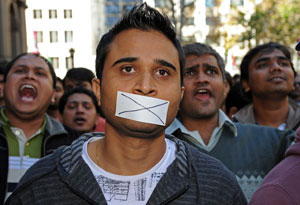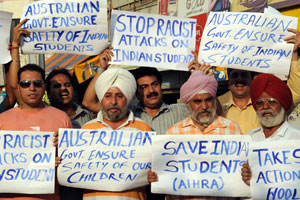State of Denial
By Mahir Ali | News & Politics | Opinion | Viewpoint | Published 14 years ago
When the Oscar-winning Bollywood composer Allah Rakha Rahman staged an open-air concert in the middle of January as part of the Sydney Festival, he noted that the extravaganza — at which he was accompanied by a troupe of 40 musicians and dancers — was intended, in part, “to spread the message of togetherness and peace [and to] build a bridge for people who are trying to break it.”
A rather less popular Indian entity, Bal Thackeray, picked more or less the same time to make a very different gesture by declaring that if Australian cricketers valued their safety, they had better not participate in next month’s Indian Premier League tournament. The Shiv Sena also announced that Australians would certainly not be allowed to play in Mumbai — a courtesy that has previously been extended to Pakistani cricketers.
Relations between India and Australia soured in the middle of last year, following a series of violent attacks against Indian students in Melbourne. At the time, the Australian authorities insisted that the assaults weren’t racially motivated. The Federation of Indian Students of Australia begged to differ, as did the Indian government. The violence was replicated in Sydney, albeit on a smaller scale, and Indian students in both cities staged noisy demonstrations.
Amitabh Bachchan refused to accept an honorary degree from the Queensland University of Technology, declaring: “My conscience is profoundly unsettled at the moment.” And in protest marches in Indian cities, effigies of Australian Prime Minister Kevin Rudd were burned. In Melbourne, meanwhile, the police force fielded a team in a friendly cricket match against Indian students, as part of an official initiative to reach out to the South Asian community.
Efforts on the part of the authorities, including an increased police presence in areas and on transport routes where most of the assaults had occurred, appeared to produce results. Although Indian student applications to Australian universities and institutes fell by 50% in the second half of 2009, this was attributed only in part to the bad publicity Australia had received in the Indian media: the global financial crisis and the strength of the Australian dollar were also deemed to have played a part.
Then, in the first week of January 2010, 21-year-old graduate student Nitin Garg was stabbed to death as he made his way on a Saturday night to the restaurant where he worked. It was back to square one. Except that this time Indian protests, official and otherwise, were even more vociferous. Senior government figures in Australia, sticking to last year’s script, vehemently rejected the possibility of racist motivation.
Emotions rose a notch further the following Saturday when a young Indian — this time not a student — was set upon by a gang late at night as he parked his car, doused in lighter fluid and set alight. Fortunately, his injuries weren’t fatal.
A few days earlier, the partially burnt remains of Ranjodh Singh had been found on a road near Sydney. He, too, wasn’t a student.
Do these incidents and the ones that occurred last year constitute a pattern? Have ocker louts discovered, a few decades after British yobs, the sadistic delights of “Paki-bashing”?
It would be imprudent to jump to conclusions, but it does not require much of a leap of the imagination to conclude that last year’s series of attacks were directed at individuals of a particular ethnicity.

Australian authorities insisted that the assaults on Indian students weren’t racially motivated. Photo: AFP
Among foreign students in Australia, Indians constitute a substantial minority. Until fairly recently, people of subcontinental origin constituted a minuscule proportion of the population: they were heavily outnumbered by Australians of Chinese origin, for instance. Of late their presence has visibly increased, accounted for chiefly by students but also by a relatively heavy migration inflow. Many of the students, too, are lured by the prospect of fast-tracked immigration formalities once they have completed their education. The trend has also given rise to educational institutions of dubious merit out to make a fast buck.
At the same time, it is historically the case that each wave of migrants to Australia has encountered local hostility. Greeks and Italians are now pretty much accepted as part of the nation’s multicultural fabric, but back in the 1950s and ’60s they were “wogs” in popular parlance. Other insults lay in store for Chinese and Vietnamese immigrants, but the vast majority of Australians now view them with equanimity, or at least resignation. Well-established migrants of Lebanese origin fall in the same category, although relatively recent arrivals from that country have faced a fair bit of hostility, exemplified by the race riots in the Sydney suburb of Cronulla in 2005.
Before all these categories, there were the Irish — and Catholics in general — who faced various kinds of discrimination. And then, of course, there are the Aborigines, who had to wait until a couple of years ago to receive an apology for policies devised essentially to breed them out of existence. When the British colonised the continent in the 18th century, the land was decreed to be a terra nullius — suggesting that the land was unoccupied. More than 200 years later, indigenous Australians remain marginalised.
It is therefore absurd to suggest that Australian racism is an oddity, although it may be less ridiculous to claim that it is broadly malleable. In a comment a few years ago, the feminist icon Germaine Greer noted that Australia is as racist as Britain. I actually found it somewhat less so when I took up residence in Australia a dozen or so years ago. There is not much evidence, for instance, of the stiff-upper-lip insularity that characterises a certain class of Britons — members of that class were unlikely to be transported to Australia when it was a penal colony; nor were they inclined to emigrate when, in the mid-20th century, the Australian government sought to stimulate population growth by offering Britons free passage plus £10 (which meant they became known as 10-pound Poms). At the time, under the openly racist White Australia Policy, swarthy foreigners were legally excluded from the immigration programme.
Australia has changed a great deal since then — Melbourne and Sydney in particular are truly multicultural cities, with areas in which shop signs in Mandarin or Arabic outnumber those in English — and, perhaps inevitably, the transformation hasn’t gone down well with a conservative minority. However, it’s not unreconstructed attitudes among a proportion of the elderly that account for racist violence, which is more or less exclusively the preserve of the young, especially in economically depressed urban neighbourhoods.
Government ministers and police officials maintain that the victimisation of Indian students has been “opportunistic” rather than racially motivated, meaning that the attacks were purely criminal in intent, with the targets picked because they were alone late at night, and possibly conspicuously carrying coveted electronic goods such as laptops or iPods, rather than because of their ethnicity or skin colour.

Enough is enough: Protesters demand action from the Australian government. Photo: AFP
Not surprisingly, such claims have encountered a great deal of scepticism in New Delhi and among Indians generally, as they appear to be based on little more than wishful thinking, given that none of the perpetrators had, at the time of writing, been tracked down.
By the same token, there is no solid basis for claiming that each instance of violence — including the murder of Nitin Garg — was propelled by race hate. There is clearly a pattern of sorts, but the possibility of exceptions must be accepted. And it is singularly counterproductive when Indians — not just the Shiv Sena but others who ought to know better — start screaming for revenge attacks. Whether or not they lead to any action, such voices can serve only to exacerbate the problem.
Australians were particularly miffed by an Indian newspaper cartoon that depicted a police officer in a Ku Klux Klan-style hooded white sheet. There’s not enough substantial evidence of racism on the part of the Melbourne police, but it’s not difficult to understand why the apparent lack of progress in its investigations might provide cause for concern.
Nor is it particularly helpful for Canberra to stridently go on insisting that Australian racism is a figment of the imagination, or that Indian students are as safe in Australia as anywhere in the world; or to point out that there is more crime in Indian cities. It would, of course, be difficult to find a society anywhere in the world that is not prone to racism in some measure. Some political parties and governments seek to exploit it, others try to combat it, while still others hope that if they pretend it does not exist, it will somehow go away.
Australia’s ruling Labour Party falls in the last of these categories, and it has not reacted well to Indian criticism — which has, it must be acknowledged, been over the top at times. The long-term risk in this attitude is that, in the absence of countermeasures, overt racism could mushroom into a much more widespread problem in the future, particularly during economically challenging times. In the short run, meanwhile, although the strains thus far in relations between Canberra and New Delhi shouldn’t prove all that hard to mend, further attacks on Indians would prove seriously damaging in that respect.
It’s perhaps just as well that the Australian team has been facing Pakistani, rather than Indian, cricketers this season or else passions between rival fans may well have served to queer the pitch.
Mahir Ali is an Australia-based journalist. He writes regularly for several Pakistani publications, including Newsline.


